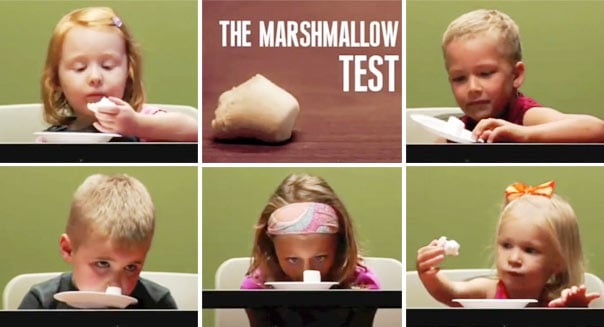Blog
5 Instructional Design Insights from The Marshmallow Test: Part 2
By Edmond Manning, Senior Instructional Strategist My favorite analysis question to ask clients is: “What if your target audience already understands ...


5 Instructional Design Insights from The Marshmallow Test: Part I
By Edmond Manning | June 01, 2017 | Custom Learning | 0 Comments
 By Edmond Manning, Senior Instructional Strategist
By Edmond Manning, Senior Instructional Strategist
My favorite analysis question to ask clients is: “What if your target audience already understands how to perform the behavior you’ve outlined, but just doesn’t feel like doing it?”
Very often, I receive a blank stare with a standard answer. “They have to do it. It’s their job.”
I never get to say what I’m thinking, “Well then, why aren’t they?”
Truth is, there are many reasons why learners don’t perform. But sometimes, they just don’t, even when they could. And should. Our field of instructional design rarely acknowledges the powerful affective influence (e.g., illogical thought processes, unconscious influencers, and the full range of emotions) on performance. People may choose not to engage in a specific behavior for any number of simple to complex reasons, all of which may be difficult to analyze and fix.
However, if you believe affect plays a role in learners choosing to engage in performance, you might be fascinated by The Marshmallow Test. In this 2014 book, researcher Walter Mischel reveals insights collected from decades of research on willpower and its relationship to decision-making. While this book was not written for instructional designers, the training implications are fascinating.
Who wants a marshmallow?
Beginning in the 1960’s, Mischel experimented with what he later named “The Marshmallow Test.” In short, preschoolers were invited into a room with toys. They were offered one marshmallow (or whatever treat appealed to them) immediately… or, if they waited until the researcher returned to the room, they could have two marshmallows.

Over fifty years, this study (and its permutations) explored various aspects of self-control and its correlation to success in life. Children of varying ages, geographic regions, and socio-economic status were tested. Some children were given strategies to resist temptation. In another variation, children were encouraged by a talking clown doll who coached them to “Give in. Eat it.”
(Aside to research types: do a study on the nightmarish impact of a talking clown doll daring you to do things. Yikes!)
In Mischel’s words:
“It took many years, but gradually a model emerged of how the mind and brain work when preschoolers and adults struggle to resist temptations and manage to succeed.”
I loved exploring his findings and considering how this intense study of affect could impact my instructional design. I’m delighted to share thoughts with you. To be clear, my perspective in this blog post is not research, nor did Mischel advocate any of these outcomes.
#1 – “Hot focus” influences how people make decisions
Mischel explains a main influencer of how people act—hot or cold focus—through dessert. Say, you’re in a favorite restaurant and see very appealing treats on the dessert menu, but you decide to “be good” and skip dessert. Your decision is made with neither particularly hot nor cold focus.
Despite your decision, the waiter returns with an overburdened tray of seven options. You spy your favorite—rich chocolate cake with a creamy ganache, slathered in buttercream frosting (okay, confession time: this is my favorite dessert). Your nose inhales the scent of raspberry from the bright red sauce drizzled around the plate’s edge. You remember how silky their buttercream frosting tastes in your mouth. You look at the waiter and say, “Changed my mind. Chocolate cake.”
Hot focus.
Your normal decision-making was influenced by a more intense, sensory context.
Now think about training.
When reviewing elearning, I often see half-hearted attempts to get learners to feel hot focus. A poor hot focus may look like this lame attempt at an customer: “I’m upset at how this situation was handled. I will take my business elsewhere.”
Yawn.
That, “I will take my business elsewhere” may strike terror into the hearts of upper management, but it doesn’t create much hot focus for those people who have to deal with belligerent customers. The learners are probably thinking, “Go. Whatever.”
Try creating a hot focus, with a customer stating, “I can’t believe this! I’m Silver status and you’re treating me like crap, (learner’s name captured from LMS login). I’m talking to your supervisor right now, and trust me, I’ll be using your name.”
The uncomfortable use of the learner’s own name, the implied threat, and realistic angry words, all might create a hotter focus, increasing stress, making the decision-making moment feel more intense.
What makes a hot focus in your training environment? Angry customers? A harried father of three almost in tears over filling out paperwork for his recently deceased wife? A pathogen in the food processing plant that eventually makes eight people sick and kills two teenagers?
Use hot focus.
(By the way, Michael Allen has been advocating hot focus for years. He calls it 'Meaningful and Memorable'.)
#2 – Cold focus is useful, too.
During the marshmallow test, kids experience hot focus because the marshmallow sits right in front of them. They can see it. Touch it. Smell it, if desired. Some children reduced the hot focus by leaving the table with the marshmallow and playing with toys in another part of the room, or putting their head in their arms and singing to themselves. They removed the hot focus’ power.
When the waiter brings the dessert tray to your table and you begin to salivate, try visualizing the cake unattended in the kitchen and two dozen cockroaches scrambling over it on their way to the sink drain. The vivid image revolts you, so you say, “I’ll pass on dessert.”
In this example, one hot focus emotion, disgust, is used to cancel another hot emotion, dessert lust. (Trust me on this—dessert lust is totally a thing.)
In your instructional design, deliberately creating a cold focus could be useful when the real-world decision is too stressful, and learners need an escape from the hot-focus decision-making moment.
For example, say you’re developing customer service training for a call center. As the learners prepare for “real-world conditions,” you add in hot focus to the training environment: conversation fragments from agents on calls in a neighboring cube, the low-level clacking of nearby computer keys, the occasional conversation as coworkers walk by on their way to the break room…anything that increases the stressful conditions under which the learner must perform. Hot focus!
During intense problem-solving, give them the option to turn off this noise—temporarily—while they research the best way to solve a caller’s problem. Give them the power to remove the hot focus. Once they’re ready to re-engage with the customer on the phone, the simulated noise returns.
Doesn’t this cold focus advice seem to contradict the advice regarding hot focus? Not at all. Both of these are merely strategies. Apply when needed.
Hot and cold focus are two more additional tools to increase the opportunities to create a more Meaningful and Memorable experience.
I just described using either hot focus or cold focus. But wait! There’s more!
#3 – Cultivate executive function.
Executive function describes a group of brain processes necessary for the cognitive control of behavior. This could include attention, inhibitions, working memory, cognitive flexibility, planning, problem-solving, and more. There’s a lot of brain research out there discussing executive function, and I ain’t gonna touch that body of research because I won’t pretend to be an expert. But, Mischel concludes that executive function works best in cold focus. Executive function works best without the sticky entanglements of hot focus.
I think there’s a wonderfully complex/simple implication. If business analysis proves training is truly needed—there’s a documented performance gap—chances are the gap is complex. Maybe not (this is a gross generality, after all). Maybe the behavior isn’t complex but the consequences are, or there isn’t much time to perform the behavior, or no time to look up resources, or…something is making this behavioral knot complex.
Make the training hot focus—make the context fit the real-world pressures. Then, cut through the hot focus with a cold focus that cultivates executive function. There does not need to be a single or simple solution. There doesn’t need to be a “one-size-fits-all” solution, but make the path to the solution immensely logical, obvious. Create hot focus and slice through it.
Make executive function the reasonable, attractive solution.
Example: eLearning for school cafeteria cashiers
I remember a former elearning project training school cafeteria cashiers. Though we did not use or know the words “hot focus” and “cold focus,” the project nevertheless balanced these seemingly opposites strategies. Public high schools and grade schools get reimbursed by the  government if a certain number of students accept healthy foods on their cafeteria lunch trays. Schools desperately need that money. To boost the numbers of students who accept healthy foods, schools demand cashiers suggested/advocated vegetables, milk, and fresh fruit. These workers were supposed to make suggestions in a screaming-loud environment, while mocked by junior-high wit (you know kids are brutal), and all of this transpiring at an alarming speed. Hurry! There are twelve kids waiting to pay for their chicken strips and tater tots.
government if a certain number of students accept healthy foods on their cafeteria lunch trays. Schools desperately need that money. To boost the numbers of students who accept healthy foods, schools demand cashiers suggested/advocated vegetables, milk, and fresh fruit. These workers were supposed to make suggestions in a screaming-loud environment, while mocked by junior-high wit (you know kids are brutal), and all of this transpiring at an alarming speed. Hurry! There are twelve kids waiting to pay for their chicken strips and tater tots.
Extremely hot focus, right?
In the training, cashiers visually observed a tray and had to evaluate what was missing. After getting scores consistently higher than 80%, a timer was added. Cashiers had to evaluate ten trays as meeting/not meeting federal guidelines within 1 minute. Stress! (Thus, increasing the hot focus). Later, when helping cashiers respond to trays lacking reimbursable foods, one important cold focus tool was to provide specific, short sentences cashiers could repeat. “Add a milk to your tray?” “Try an apple.”
The training would not have succeeded (and it did succeed) without both: recreating the hot focus of the chaotic school cafeteria setting while providing simple tools to harried employees to cut through that hot focus, allowing them to access executive function more readily.
How might hot and cold focus apply to your unique training challenges?
Wait, don’t go! I’m not done discussing marshmallows!
Come back to learn more about the power of addressing your future self…
CLICK TO TWEET:

About the Author: Edmond Manning
Edmond Manning, senior instructional designer for Allen Interactions, has more than 20 years designing interactive e-learning experiences on instructional topics including: software simulation, medical ethics, supervisory skills, and selling/presentation skills, and gosh, a whole bunch of others. He has helped mentor and grow e-learning departments, worked as a business consultant, independent contractor, and instructed the ATD e-Learning Instructional Design Certificate Program for more than a decade. Edmond has a master's degree from Northern Illinois University in instructional technology.
Comments
Would you like to leave a comment?
Related Blog Posts

By: Edmond Manning | Jun, 2017
Category: Custom Learning

Blog
11 Instructional Design Truths According to Cat .gifs
By Edmond Manning, Senior Instructional Strategist My favorite analysis question to ask clients is: “What if your target audience already understands ...
By: Edmond Manning | Oct, 2019
Category: Custom Learning

Blog
Pokémon Go: 3 Lessons for Instructional Designers
By Edmond Manning, Senior Instructional Strategist My favorite analysis question to ask clients is: “What if your target audience already understands ...
By: Edmond Manning | Jul, 2016
Category: Custom Learning

